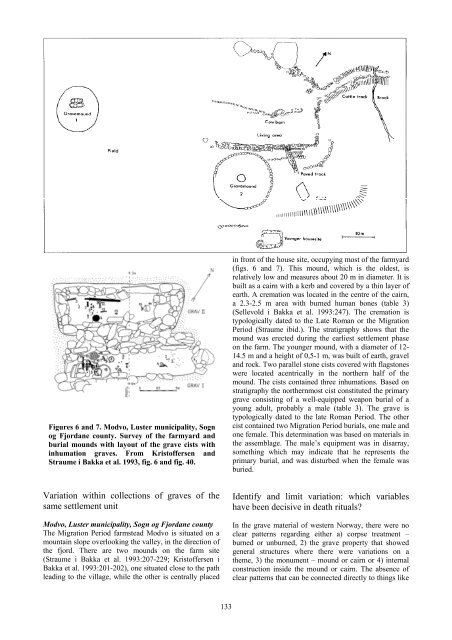The Materiality of Death - mikroarkeologi.se
The Materiality of Death - mikroarkeologi.se
The Materiality of Death - mikroarkeologi.se
You also want an ePaper? Increase the reach of your titles
YUMPU automatically turns print PDFs into web optimized ePapers that Google loves.
Figures 6 and 7. Modvo, Luster municipality, Sogn<br />
og Fjordane county. Survey <strong>of</strong> the farmyard and<br />
burial mounds with layout <strong>of</strong> the grave cists with<br />
inhumation graves. From Krist<strong>of</strong>fer<strong>se</strong>n and<br />
Straume i Bakka et al. 1993, fig. 6 and fig. 40.<br />
in front <strong>of</strong> the hou<strong>se</strong> site, occupying most <strong>of</strong> the farmyard<br />
(figs. 6 and 7). This mound, which is the oldest, is<br />
relatively low and measures about 20 m in diameter. It is<br />
built as a cairn with a kerb and covered by a thin layer <strong>of</strong><br />
earth. A cremation was located in the centre <strong>of</strong> the cairn,<br />
a 2.3-2.5 m area with burned human bones (table 3)<br />
(Sellevold i Bakka et al. 1993:247). <strong>The</strong> cremation is<br />
typologically dated to the Late Roman or the Migration<br />
Period (Straume ibid.). <strong>The</strong> stratigraphy shows that the<br />
mound was erected during the earliest <strong>se</strong>ttlement pha<strong>se</strong><br />
on the farm. <strong>The</strong> younger mound, with a diameter <strong>of</strong> 12-<br />
14.5 m and a height <strong>of</strong> 0,5-1 m, was built <strong>of</strong> earth, gravel<br />
and rock. Two parallel stone cists covered with flagstones<br />
were located acentrically in the northern half <strong>of</strong> the<br />
mound. <strong>The</strong> cists contained three inhumations. Ba<strong>se</strong>d on<br />
stratigraphy the northernmost cist constituted the primary<br />
grave consisting <strong>of</strong> a well-equipped weapon burial <strong>of</strong> a<br />
young adult, probably a male (table 3). <strong>The</strong> grave is<br />
typologically dated to the late Roman Period. <strong>The</strong> other<br />
cist contained two Migration Period burials, one male and<br />
one female. This determination was ba<strong>se</strong>d on materials in<br />
the as<strong>se</strong>mblage. <strong>The</strong> male’s equipment was in disarray,<br />
something which may indicate that he repre<strong>se</strong>nts the<br />
primary burial, and was disturbed when the female was<br />
buried.<br />
Variation within collections <strong>of</strong> graves <strong>of</strong> the<br />
same <strong>se</strong>ttlement unit<br />
Modvo, Luster municipality, Sogn og Fjordane county<br />
<strong>The</strong> Migration Period farmstead Modvo is situated on a<br />
mountain slope overlooking the valley, in the direction <strong>of</strong><br />
the fjord. <strong>The</strong>re are two mounds on the farm site<br />
(Straume i Bakka et al. 1993:207-229; Krist<strong>of</strong>fer<strong>se</strong>n i<br />
Bakka et al. 1993:201-202), one situated clo<strong>se</strong> to the path<br />
leading to the village, while the other is centrally placed<br />
Identify and limit variation: which variables<br />
have been decisive in death rituals?<br />
In the grave material <strong>of</strong> western Norway, there were no<br />
clear patterns regarding either a) corp<strong>se</strong> treatment –<br />
burned or unburned, 2) the grave property that showed<br />
general structures where there were variations on a<br />
theme, 3) the monument – mound or cairn or 4) internal<br />
construction inside the mound or cairn. <strong>The</strong> ab<strong>se</strong>nce <strong>of</strong><br />
clear patterns that can be connected directly to things like<br />
133
















